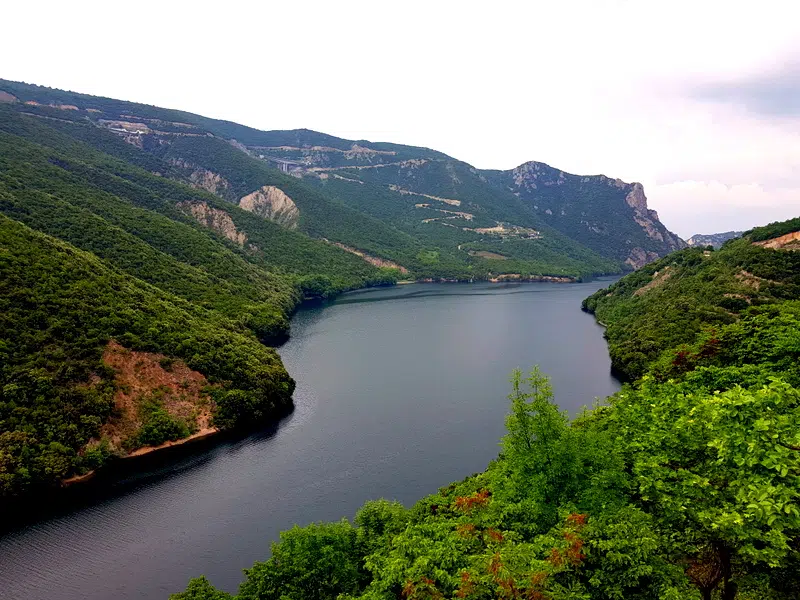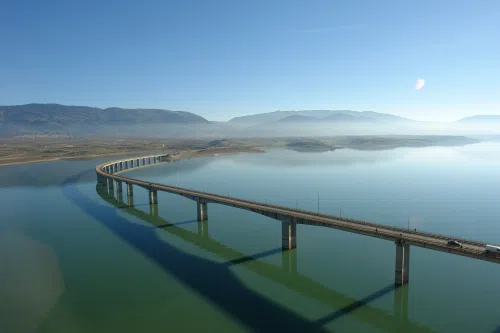
Nestled in the heart of Greece’s rugged landscape lies the Haliacmon River. Known to modern Greeks as ”Aliakmonas”, this river has been the nation’s silent witness. Have you ever wondered what stories the longest river in Greece could tell us, following thousands of years and numerous of civilizations that crossed it?
Haliacmon is Greece’s longest river
Spanning an impressive journey from the beautiful slopes of the Pindos mountain range to the sea of the Thermaic Gulf, the Haliacmon carves its path through mainland Greece. Actually, this beautiful river passes through several regions of northern Greece.
Its waters meander through valleys covered in trees and ancient lands. As the river flows along the Greek mainland, it manages to curve the land, creating breathtaking scenes. This is why the Haliacmon river has been among the favourites in nature lovers circles.
In ancient times, the famous Alexandrian geographer and mathematician Claudius Ptolemy named the mountain range where the Haliacmon River begins. The exact location lies in the northern part of the Pindus mountains, with Ptolemy calling it the Canalovii.
On his behalf, Julius Caesar had mentioned that the Haliacmon River was marking the boundary between the regions of Macedon and Thessaly, two important regions of the Greek peninsula during the Roman Empire.
Initially, the river flows southeast through the area known as Elimiotis or Elimeia. The river then makes a sudden turn northeast, creating a natural divide between today’s regional units of Pieria, Eordaea (in Kozani), and Imathia.

Echoes of the past along the riverbanks of Haliacmon
According to the ancient historian Herodotus, the Haliacmon once merged with the Loudias River, which was the outlet of Lake Pella. However, over time, the course of the Loudias changed.
Due to natural and geographical changes over the centuries, the Loudias river no longer meets the Haliacmon but instead flows directly into the Aegean Sea. Today, a wind gap between the Haliacmon and Loudias watersheds marks what is believed to be the ancient path of the Haliacmon River.
The Haliacmon is not just the longest river that flows exclusively within Greece’s land. It’s a repository of Greece’s history. Of centuries of battles, fights, cultural exchanges and enemy conquests. Ancient civilizations have thrived and died along its banks. Kings and Tyrants were drawn by its generous waters and fertile soils.
Ancient myths and legends continue to whisper across its banks, telling tales of gods and heroes. Characters who actually lived or simply existed in the imagination of the Greeks. People whose fates were linked, one way or another, with this majestic river.
The epicentre of local biodiversity
Amidst the deep waters, the Haliacmon is a local epicentre of life, boasting a remarkable array of flora and fauna. From rare birds that fly across the sky of northern Greece to the 33 different kinds of fish that live in its crystal-clear depths, the river supports a vibrant ecosystem.
An impressive thirty of them are indigenous, making this river even more important for the broader region. One of these types of fish, the ”mavrotsironi” is only found in the waters of this river and nowhere else in the world.
The delta of the Haliacmon River has expanded to an impressive 4,000 hectares over the years. This has created habitats for many fish like flathead mullets and European seabasses.
The delta is also very important for the reproduction of many fish that live in the Aegean Sea. It also produces a stunning 90% of Greece’s total production of mussels, making it an important economic hub too. Additionally, the Aliki Kitrous area produces approximately 15–20,000 tons of salt every year. The area is also known as the Axios, Haliacmon and Loudias delta.
Within the river and the surrounding areas, an impressive 215 bird species has been recorded over the years. The birds use the river primarily for shelter, to nestle, and as a resting spot during their long migration journeys. Remarkably, one in ten of these species are categorized as endangered, with notable examples including the Dalmatian pelican and the curlew.
Today, the Haliacmon continues to play an important role in the lives of those who live around it and the country as a whole. Its flow supports agriculture in northern and central Greece, providing valuable water in a country with scorching heat and dry weather in the summer.
See all the latest news from Greece and the world at Greekreporter.com. Contact our newsroom to report an update or send your story, photos and videos. Follow GR on Google News and subscribe here to our daily email!



